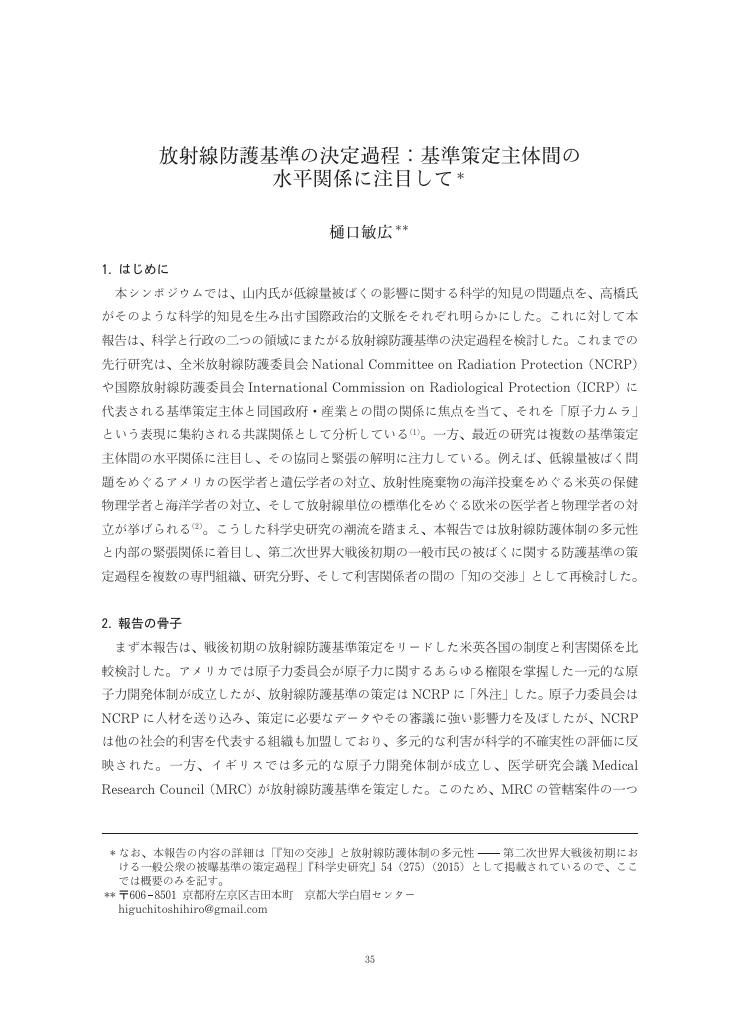17 0 0 0 OA 作られた無知の諸相 ――科学史・社会学・ジェンダー研究の視点から
3 0 0 0 OA 核実験問題と日米関係-「教育」過程の生成と崩壊を中心に-
- 著者
- 樋口 敏広
- 出版者
- JAPAN ASSOCIATION OF INTERNATIONAL RELATIONS
- 雑誌
- 国際政治 (ISSN:04542215)
- 巻号頁・発行日
- vol.2003, no.134, pp.103-120,L14, 2003-11-29 (Released:2010-09-01)
- 参考文献数
- 66
The Bikini incident of 1954, ushering in a new era of atomic plenty, aggravated nuclear fear and a danger of neutralism among the Japanese public. This article examines how the Japanese and U. S. governments tackled a problem of antinuclear sentiment which emerged as a hotbed for neutralism in 1954-1957. Focusing on a unique nature of Japanese antinuclear sentiment as a form of nationalism, this article sheds light upon a role of diplomacy as a communication tool to address antinuclear sentiment and nationalism.This study argues that the Yoshida administration succeeded in settling an immediate problem of the Bikini incident but failed to address the question of nationalism deeply rooted in spreading antinuclear sentiment among the public. Worried about a weak leadership of the Japanese conservative government, the Eisenhower administration could not simply overlook this failure. Then it tried to directly confront the growing antinuclear sentiment through a coordinated public relations diplomacy it regarded as “education.” With “education, ” it intended to lead Japan to embrace continued nuclear-testing. This “education” failed, however, when Prime Minister Nobusuke Kishi embarked upon anti-nuclear-testing diplomacy. By positively responding to the growing nationalism embedded in the antinuclear sentiment, Kishi thought, he could win popularity for pro-American conservative LDP and therefore contain a danger of neutralism. Containment of neutralism was, ironically, exactly what the Eisenhower administration had envisaged. Kishi's diplomacy, therefore, shared the goal with U. S. educational efforts, but adopted a different approach. His diplomacy finally nullified “education, ” which raised a voice inside the Eisenhower administration calling for changing U .S. policy on nuclear testing rather than changing Japan through “education.” The eventual course of antinuclear nationalism in U. S. -Japan relations once again remained to be seen.
1 0 0 0 OA 放射線防護基準の決定過程:基準策定主体間の水平関係に注目して
- 著者
- 樋口 敏広
- 出版者
- 日本科学史学会生物学史分科会
- 雑誌
- 生物学史研究 (ISSN:03869539)
- 巻号頁・発行日
- vol.93, pp.35-38, 2015-12-20 (Released:2019-06-03)
1 0 0 0 OA 「核による平和」に地球環境的限界はあるか
- 著者
- 樋口 敏広
- 出版者
- 財団法人 日本国際政治学会
- 雑誌
- 国際政治 (ISSN:04542215)
- 巻号頁・発行日
- vol.2011, no.163, pp.163_28-40, 2011-01-20 (Released:2013-05-10)
- 参考文献数
- 60
In the 1950s, as the Cold War set in and nuclear arms race accelerated apace, the worldwide contamination by radioactive fallout from nuclear tests triggered a fierce controversy. The Eisenhower administration, whose pursuit of national security through nuclear superiority led to the production of environmental insecurity, sought to contain the latter through environmental monitoring and risk evaluation. Informed by the sociological theory of risk, this article interrogates Cold War America's nexus of scientific knowledge and political power that underpinned this first global environmental crisis of the Cold War.At the heart of the controversy was a much contested “proper perspective” of risk. Critics noted an absolute increase of harm by fallout and warned about the unknowns in its nature and scale. Washington, in contrast, emphasized the knowns, backed them up with its monopoly of monitoring data, and pushed the burden of proof upon the critics. It also adopted a comparative framework that mirrored the double-binding consensus of national security and high modernity, in which the risk from fallout appeared “negligible” compared to natural and artificial radiations, socially accepted risks, and benefits of atomic energy. The Eisenhower administration even pursued a technological solution of “cleaning up” nuclear bombs to justify the continuation of nuclear tests as well as to break an emerging taboo surrounding the use of nuclear explosives for war and peace.Cold War America's leadership in the risk evaluation in and out of the United States, however, proved to be far from absolute or static. The U.S. Atomic Energy Commission, an all-powerful national security state institution which underwrote the government's safety assurances, suffered much from the growing public mistrust due to the embedded conflict of interests between promotion and regulation. The commission of a risk review to the National Academy of Sciences hardly helped the government when the British counterpart issued a more conservative report. At the United Nations, the Soviet Union became assertive in challenging the logic of America's risk judgment as its scientists were rebuilding the knowledge basis of radiation biology and genetics and absorbing an alternative risk perspective through their transnational communication with Western experts. The resultant shift of consensus toward a more conservative risk assessment, in turn, increasingly narrowed the latitude of test ban policy for the Eisenhower administration, which eventually decided to abandon an option of atmospheric tests in 1959. Beyond the test ban, the transformed consensus also led Washington to reconsider the fundamental promise of “peace through nuclear superiority”, ironically, in a way to reinforce it. In short, the fallout controversy revealed the dynamic co-evolution of risk knowledge and nuclear policy for Cold War America.
